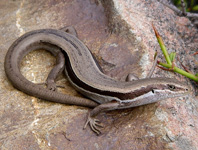Abstract
The black fly Prosimulium italicum Rivosecchi, distributed in the Apennines and Sicily, was described as a subspecies of Prosimulium hirtipes (Fries), based on a few morphological details. It subsequently was considered conspecific with P. hirtipes and the name was synonymized. Analyses of polytene chromosome banding patterns and sequences of mitochondrial DNA (COI and COII) revealed deep genetic divergence between P. italicum from Italy and P. hirtipes from northern and central Europe and confirmed the species status of P. italicum. Populations of P. italicum either lack chromosomal inversion IS-9 or carry it as an X-chromosome polymorphism, whereas all analyzed populations of P. hirtipes (Slovakia, Sweden, England, and Scotland) are fixed for IS-9. The average K2P genetic distance was 3.7% between P. italicum and P. hirtipes from northern Europe (Sweden) and 4.3 % between P. italicum and P. hirtipes from central Europe (Slovakia). Cytogenetic analysis showed the presence of two cytoforms of P. hirtipes (‘A’ in Sweden and Slovakia and ‘B’ in England and Scotland) and two cytoforms of P. italicum (‘A’ in Sicily and ‘B’ in Campania and Basilicata), all of which differ in their sex chromosomes and autosomal polymorphisms, suggesting that P. hirtipes and P. italicum might each be a complex of cryptic species.
References
Adler, P.H. & Belqat, B. (2001) Cytotaxonomy of the Prosimulium hirtipes species group (Diptera: Simuliidae) in Morocco. Insect Systematics & Evolution, 32, 411–418.
https://doi.org/10.1163/187631201X00281Adler, P.H. & Crosskey, R.W. (2017) World blackflies (Diptera, Simuliidae): a comprehensive revision of the taxonomic and geographical inventory [2017]. 131 pp. Available from: http://www.clemson.edu/cafls/biomia/pdfs/blackflyinventory.pdf (accessed 5 October 2017)
Adler, P.H. & Şirin, Ü. (2014) Cytotaxonomy of the Prosimulium (Diptera: Simuliidae) of Western Asia. Zoological Journal of the Linnean Society, 171, 753–768.
https://doi.org/10.1111/zoj.12150Adler, P.H. & Şirin, Ü. (2015) A new species of black fly in the Prosimulium hirtipes (Fries) group (Diptera: Simuliidae) from Western Turkey. Proceedings of the Entomological Society of Washington, 117, 85–94.
https://doi.org/10.4289/0013-8797.117.2.85Bandelt, H.J., Forster, P. & Röhl, A. (1999) Median-joining networks for inferring intraspecific phylogenies. Molecular Biology and Evolution, 16, 37–48.
https://doi.org/10.1093/oxfordjournals.molbev.a026036Basrur, P.K. (1959) The salivary gland chromosomes of seven segregates of Prosimulium (Diptera: Simuliidae) with a transformed centromere. Canadian Journal of Zoology, 37, 527–570.
https://doi.org/10.1139/z59-059Basrur, P.K. (1962) The salivary gland chromosomes of seven species of Prosimulium (Diptera: Simuliidae) from Alaska and British Columbia. Canadian Journal of Zoology, 40, 1019–1033.
https://doi.org/10.1139/z62-089Carlsson, G. (1962) Studies on Scandinavian black flies (fam. Simuliidae). Opuscula Entomologica, 21, 1–280.
Crosskey, R.W. & Howard, T.M. (1997) A new taxonomic and geographical inventory of world blackflies (Diptera: Simuliidae). The Natural History Museum, London, 144 pp.
Darriba, D., Taboada, G.L., Doallo, R. & Posada, D. (2012) jModelTest 2: more models, new heuristics and high-performance computing. Nature Methods, 9, 772.
https://doi.org/10.1038/nmeth.2109Folmer, O., Black, M., Hoeh, W., Lutz, R. & Vrijenhoek, R. (1994) DNA primers for amplification of mitochondrial cytochrome c oxidase subunit I from diverse metazoan invertebrates. Molecular Marine Biology and Biotechnology, 3, 294–299.
Funk, D.J. & Omland, K.E. (2003) Species-level paraphyly and polyphyly: frequency, causes, and consequences, with insights from animal mitochondrial DNA. Annual Review of Ecology, Evolution, and Systematics, 34, 397–423.
https://doi.org/10.1146/annurev.ecolsys.34.011802.132421Hellgren, O., Bensch, S. & Malmqvist, B. (2008) Bird hosts, blood parasites and their vectors — associations uncovered by molecular analyses of blackfly blood meals. Molecular Ecology, 17, 1605–1613.
http://doi.org/10.1111/j.1365-294X.2007.03680.x
Jedlička, L. (1993) Role of black fly species in the identification of stream zones in West Carpathian Mountains (Diptera, Simuliidae). Dipterologica bohemoslovaca, 5, 29–34.
Kearse, M., Moir, R., Wilson, A., Stones-Havas, S., Cheung, M., Sturrock, S., Buxton, S., Cooper, A., Markowitz, S., Duran, C., Thierer, T., Ashton, B., Mentjies, P. & Drummond, A. (2012) Geneious Basic: an integrated and extendable desktop software platform for the organization and analysis of sequence data. Bioinformatics, 28, 1647–1649.
https://doi.org/10.1093/bioinformatics/bts199Knoz, J. (1965) To identification of Czechoslovakian black-flies (Diptera, Simuliidae). Folia Facultatis Scientiarium Naturalium Universitatis Purkynianae Brunensis, Biologia, 2, 1–54.
Kumar, S., Stecher, G. & Tamura, K. (2016) MEGA7: Molecular Evolutionary Genetics Analysis version 7.0 for bigger datasets. Molecular Biology and Evolution, 33, 1870–1874.
https://doi.org/10.1093/molbev/msw054Rivosecchi, L. (1967) I Simulidi degli Appennini. Parassitologia, 9, 129–304.
Rivosecchi, L. (1978) Simuliidae (Diptera, Nematocera). Fauna d'Italia, Vol. 13. Edizioni Calderini, Bologna, 553 pp.
Rivosecchi, L. & Cardinali, R. (1975) Nuovi dati tassonomici. Rivista di Parassitologia, 26, 55–78.
Rivosecchi, L. & Osella, G. (1971) C.C.S.I. XVII—Su qualche Simulide catturato sull'uomo. Memorie del Museo Civico di Storia Naturale di Verona, 18, 337–342.
Rivosecchi, L., Addonisio, M. & Maiolini, B. (2007) Ditteri Simulidi: nuove chiavi dicotomiche per l'identificazione delle specie italiane con brevi note biotassonomiche. In: Quatderni del Museo Tridentino di Scienze Naturali. Vol. 2. Museo Tridentino di Scienze Naturali, Trento, pp. 1–148.
Rothfels, K.H. & Dunbar, R.W. (1953) The salivary gland chromosomes of the black fly Simulium vittatum Zett. Canadian Journal of Zoology, 31, 226–241.
https://doi.org/10.1139/z53-020Tamura, K. & Nei, M. (1993) Estimation of the number of nucleotide substitutions in the control region of mitochondrial DNA in humans and chimpanzees. Molecular Biology and Evolution, 10, 512–526.
Swofford, D.L. (2002) PAUP*. Phylogenetic Analysis Using Parsimony (*and Other Methods). Version 4. Sinauer Associates, Sunderland, Massachusetts. [software]
Vinçon, G. & Clergue-Gazeau, M. (1993) Les simulies (Diptera, Simuliidae) du sud-ouest de l'Europe: le crenal et l'epirhithral. Annales de Limnologie, 29, 157–169.
https://doi.org/10.1051/limn/1993014

